Pathfinder Boundary Waters Dogsledding & Cross Country Skiing
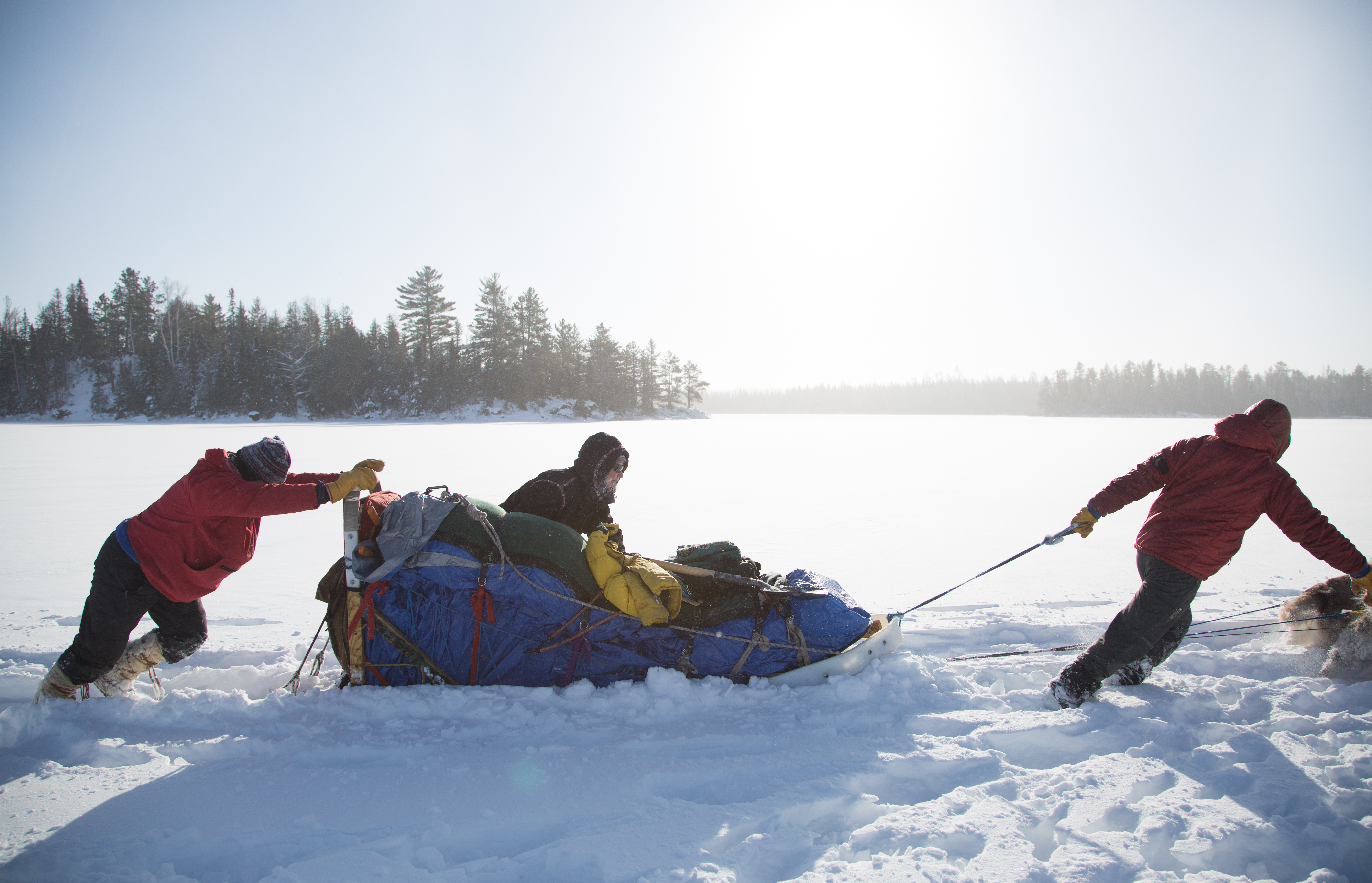 A Pathfinder course provides the opportunity for participants to chart a path, the motivation to begin their journey, resilience to recover from set-backs and the skills required to achieve their goals.
A Pathfinder course provides the opportunity for participants to chart a path, the motivation to begin their journey, resilience to recover from set-backs and the skills required to achieve their goals.
Boundary Waters Canoe Area Wilderness (BWCAW)
Over 10,000 years ago, continental-sized glaciers scraped their way across much of Ontario and northern Minnesota leaving deep ruts, ravines, and holes in their tracks. Eventually, as the glaciers melted, these ravines filled with water, creating a seemingly endless interconnected web of lakes and rivers.
In 1978, the United States designated over 1-million acres of this Northern Minnesota landscape as a protected wilderness area called the Boundary Waters Canoe Area Wilderness (BWCAW). Because no roads, power lines, or motorized craft may enter its borders, the BWCAW has remained relatively unchanged since the glaciers receded. The BWCAW extends nearly 150 miles along the Canadian border and encompasses more than 1,000 lakes and rivers. Over 1,200 miles of navigable routes lead to over 2,200 campsites and provide an unparalleled opportunity to travel by canoe and dogsled.
In the winter, the BWCAW transforms into an even more severe and remote wilderness. While more difficult, winter enthusiasts’ travel over frozen lakes and rivers by dogsled, cross-country ski and snowshoe. Winter in the Boundary Waters is mesmerizing, peaceful, and exhilarating. It is a place of spectacular extremes, trackless snow, bracing cold air, glowing warm embers, and powerful silence.
Solo – Weather and time permitting, an Outward Bound Solo experience provides an important break from the rigors of the expedition and gives students the opportunity to reflect on their Outward Bound experience. The duration of Solo depends on the course length and type as well as the competency and preparedness of the student group. Students on a 3-week course typically spend 2-nights on Solo while students on a 1-week course may spend one night or even just a few hours on Solo. Regardless of Solo length, all students receive sufficient food, water, and shelter to keep them safe and healthy during Solo. Instructors choose Solo sites to offer as much solitude as possible while retaining some proximity to the whole group. While students spend the majority of their Solo time alone, Instructors do check on each student as often as needed, usually 1-4 times per day, to ensure that each student feels safe and comfortable. Instructors work with each student individually to structure a successful, unique Solo experience that meets their specific needs. Solo is purposefully scheduled near the end of the expedition so students have plenty of time to acclimate to their new environments beforehand.
Students often have mixed feelings leading up to Solo. Inevitably, students feel some nervousness and hesitation but are also excited to rest, reflect and test their new skills after spending many days in the wilderness. Students often find that Solo provokes profound and powerful learning in a short period of time and Solo often becomes one of the most memorable parts of their Outward Bound experience.
Final Expedition – Outward Bound believes that an appropriate amount of independence is a powerful educational tool. In order to deliver that benefit, Outward Bound purposefully and gradually transfers certain leadership responsibilities to the students culminating with our “Final Expedition.” Near the end of course, if you and your group have demonstrated the necessary leadership, team problem-solving and wilderness living skills, you may be given the opportunity to travel without your instructors immediately present. Students on courses designed for ages 16 and older may travel without instructors immediately present (although they will be near the group for safety reasons) for one to five days depending on course length, student age, staff assessment of students’ abilities, and terrain. Many of our students feel this phase of the course is the most rewarding as the group learns to work together, problem solve, and accomplish a goal independently while utilizing all the skills they have acquired.
Personal Challenge Event – Time and weather permitting, Voyageur Outward Bound School courses end with a Personal Challenge Event (PCE), a final individual physical push. In the summer, the PCE usually includes a triathlon-style paddle, portage, and run. In the winter, the PCE involves a distance ski, sauna, and polar plunge.
The PCE is non-competitive. Each student sets his/her own time goal for completion and works toward it to see how their mental and physical stamina has grown as a result of their wilderness expedition. Students celebrate the completion of their wilderness expedition and PCE with a final banquet and graduation ceremony at the basecamp.
Dogsledding and Skiing - The small town of Ely, Minnesota, where the Voyageur Outward Bound School is located, is known as the dogsledding capitol of the lower 48 states for good reason. The Boundary Waters Canoe Area Wilderness, one of the most historically significant and remote wilderness areas in North America, is located just outside Ely’s back door and as temperatures drop, winter transforms these historic canoe routes into beautiful, snow-covered environments ideal for winter travel. During a Voyageur Outward Bound School Dogsledding and Skiing expedition, students travel over frozen lakes and rivers while learning how to manage teams of huskies, cross-country ski, navigate with a map and compass, check ice-conditions, process firewood, and generally stay comfortable in potentially sub-zero temperatures. The group usually consists of 9 people, 7 students and 2 Instructors, and splits into two smaller groups each day. Half the group travels on cross-country skis and is responsible for breaking trail, navigating, scouting for hazards, and checking for safe ice conditions. The other half of the group follows on dogsleds, transporting most of the equipment, and food. Mushing is not a passenger sport and, depending on the snow conditions, often requires mushers to push the sled or run and walk along with the dogs. If the skiing group encounters particularly rough terrain or steep hills, they wait for the mushers to arrive and help maneuver the heavy dogsleds. Groups travel during the day and look for an appropriate camping spot each evening.
Winter Camping - Winter weather in Minnesota varies dramatically from harsh, cold wind to bright, less-cold sunshine, but in general it’s always cold. Temperatures range from -40 to 20 degrees in the heart of the winter (December through February) and -20 to 50 degrees as spring approaches in March. Living outside during a northern winter requires the right equipment, skills, and teamwork, but it can be done comfortably. Instructors teach students how to mitigate cold weather risks, dress appropriately, and manage body temperature with food and exercise.
In order to minimize environmental impact, groups cook and sleep directly on frozen lakes. For this reason, groups always look for a sheltered bay out of the wind each evening. Upon reaching camp, groups divide camp chores to set up camp efficiently. Students learn to take care of sled dogs, set up sleeping shelters, cook meals over a fire, and saw and split firewood. If the weather is particularly cold or wet groups might setup the wall-tent, a large canvas tent with a woodstove. The wall-tent gets very warm and is large enough to fit the entire group inside.
Course End – All courses end with a shower, graduation ceremony and celebration dinner. Shower facilities are available at the basecamp.
Family Conversation - Outward Bound contacts parents at various times throughout the expedition to share updates about the group’s experience and how individual students are progressing. Towards the end of the course, after students have completed the expedition and returned to the basecamp, Instructors schedule a phone call with each family. The call will include a conversation between one instructor and the student’s parents and is an opportunity for parents to learn more about their child’s Outward Bound experience, where he/she struggled and thrived, and how he/she is preparing to return home. After that is a conversation between the student and his/her parents facilitated by the Instructor. Outward Bound students often experience considerable growth and development in a short period of time during their expeditions. The Pathfinder phone conference is an effort to equip families with the tools and vocabulary to sustain this growth and forward momentum after the student leaves Outward Bound.
Service – Service is an integral part of the Outward Bound curriculum. In addition to practicing Leave No Trace® ethics on all Outward Bound expeditions, Outward Bound also coordinates service projects with land management agencies like the US Forest Service, Bureau of Land Management, National Park Service, and local land agencies. For the most part, service projects will be done outside, and all service projects will be in a socially distant manner. Most Outward Bound students have an opportunity to participate in at least one service project during their course. Intercept courses always include 2-4 days of community service.
The following is an example of what your course itinerary may look like. Your actual itinerary will vary according to weather, student skills and abilities, and instructor preferences.
Day 1: The course begins at the Duluth Airport before transporting to the Voyageur Outward Bound School basecamp near Ely, MN. Meet your Outward Bound Instructors, organize your equipment, eat dinner and sleep outside on the very first night of the course.
Days 2-5: Participate in a cross country skiing lesson before departing the basecamp and entering the Boundary Waters Canoe Area Wilderness. During this first training expedition, everyone skis and pulls a pulk sled full of equipment. Learn how to prevent cold injuries, navigate with a map and compass, read ice conditions and construct sleeping shelters. You will travel during the day and camp in the evenings.
Days 6-8: Return to the basecamp to prepare for the next phase of the expedition. Pack food and equipment, plan a route, meet your dog teams, practice dogsledding on day-trips around the basecamp and sleep in a wood-stove heated cabin.
Days 9-17: Depart the basecamp and enter the Boundary Waters Canoe Area Wilderness for the main phase of the expedition. Half the group travels by ski and half by dogsled, switching from day to day. Learn to care for a team of huskies, process firewood, cook over a fire, and stay warm in sub-zero temperatures as you travel and camp along your route.
Days 18-20: Spend one full day and two nights alone in your own quiet, bay for the Solo phase of the expedition. Test new skills by building fires, cooking hot meals and constructing a sleeping shelter.
Days 21-24: Execute the final phase of the expedition as a group with less guidance from your Outward Bound Instructors. Continue to travel and camp as you make your way back to the basecamp.
Days 25-26: Return to the basecamp and clean equipment before taking a sauna and polar plunge in the frozen river (through a hole cut in the ice). Take a hot shower, eat indoor meals and sleep in a wood-stove heated cabin.
Day 28: Participate in a day of service projects around the Outward Bound basecamp and within the local community.
Day 29: Share expedition stories with your parents through an instructor-facilitated phone conversation before participating in an evening Outward Bound graduation ceremony.
Day 30: Eat an early indoor breakfast before departing for the airport and traveling home.
Pathfinder expeditions are a part of our Gap Year /Semester program, designed and facilitated with very specific goals and outcomes in mind that can be achieved on 30-day expeditions. Pathfinder courses seek to give students a better understanding of where they are in life, what they desire and value, and how to move forward in a direction aligned with those desires and values. Instructors focus on the development of personal character, personal awareness and personal direction and facilitate activities and conversations that help students clarify their values,develop positive leadership skills and set goals for the future.
Although each Outward Bound experience is unique, certain key components are a part of every Pathfinder course. Each course begins with a wilderness expedition. Instructors work closely with students to impart the necessary skills to overcome a variety of expedition challenges and mentor them through the process of self-discovery. All of this learning happens in a community environment with fellow expedition members. The idea that students are “crew, not passengers” is central to the Outward Bound learning approach. Wilderness living does not encourage students to contribute to acts of daily life; it requires it. As students learn to cook, care for equipment, stay warm, navigate and plan routes together, they become more aware of one another and how their individual actions affect the group’s ultimate success or failure. As the course nears the end, instructors may gradually transfer leadership responsibilities to the students, culminating with a Final Expedition. During the Final Expedition, students work as a team and apply the skills they have acquired to solve problems and make group decisions, but also reflect on how they can actualize Outward Bound values, reinforce leadership potential, utilize self-awareness techniques and achieve personal goals in their everyday life and future.
The expedition phase of an Outward Bound Pathfinder course is designed to focus on:
- Increasing self-knowledge and awareness
- Improving goal-setting and decision-making processes
- Developing self-efficacy and perseverance.
Participants at the end of the course will have completed:
- Written list of personal values
- Completed Self-assessment form
- Personal mission statement (Common curriculum but not required)
- Life Map (Common curriculum but not required)
- Written Goals for 1-week, 1-month, and 1-year
- Participate in a phone call to share their experience, self-awareness and new life goals
- Written evaluation from instructors
- 12+ hours of service to others
Weather is always a factor when traveling in the wilderness and it adds an exciting element of challenge to each course. Learning to handle varying weather conditions is essential to a successful wilderness course.
Minnesota’s weather can be unpredictable with a wide range of temperatures. Between December and March Minnesota temperatures can range from -40 to 40 degrees Fahrenheit, but -20 to 20 degree nights and days are the most common. Days are typically very sunny with bright blue skies. Wind and snow are common.
Weather is always a factor when traveling in the wilderness and it adds an exciting element of challenge to each course. Learning to handle varying weather conditions is essential to a successful wilderness course.
Please utilize the resources below to physically and mentally prepare for your course. The more preparation you do, the better your experience will be!
Winter Course Life - A Student's Perspective
Physically Preparing for a Dog Sledding Course - A Staff Perspective
Your full tuition payment is due by the deadline in your applicant portal. Please make your payment by that deadline.
We hope you look forward to your Outward Bound course! Now let us help you protect your investment. We partner with InsureMyTrip to offer our students a travel insurance option that will help protect your course from several different disruptions. Together Outward Bound and InsureMyTrip will be here for you before, during, and after your trip. We strongly recommend that you purchase trip insurance to protect your investment in your course. Voyageur Outward Bound School tuition is non-refundable.
You may choose to purchase trip related insurance through InsureMyTrip or a different insurance provider. In either case, the amount and type of coverage you choose is your responsibility and must be discussed directly with the provider.
CLICK HERE TO RECEIVE A FREE QUOTE FROM INSURE MY TRIP
You can find additional information about InsureMyTrip in the cancellation policies.
Camp & Shelter Set-Up for Winter Courses
After traveling across frozen lakes and portages, you'll arrive at your campsite for the night. Your group will work together, spending 2-3 hours setting up camp and caring for dogs. Your group will gather a significant amount of firewood for cooking, heating & boiling water, and drying out gear.
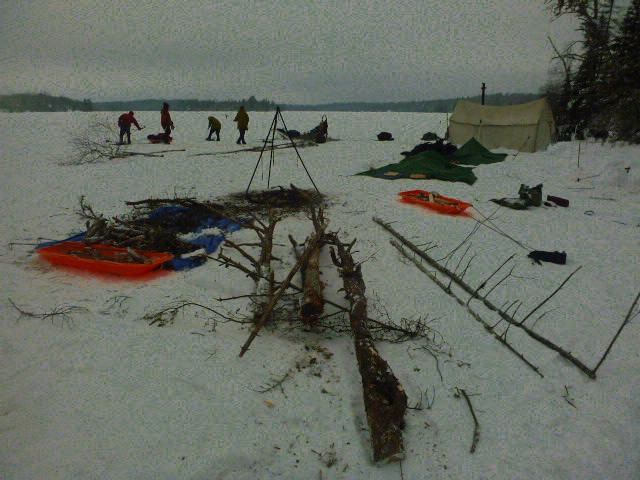
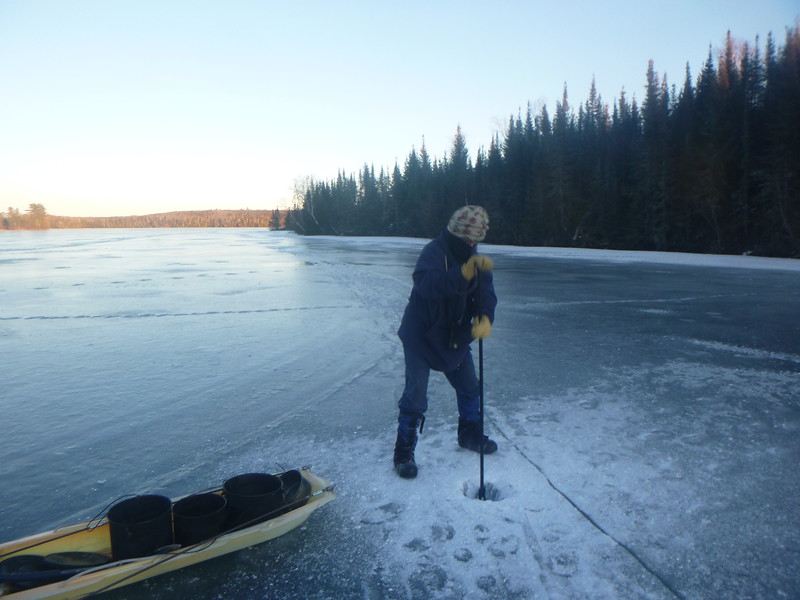
Setting up camp also involves sleddog care, chopping a hole in the ice for water, putting up sleeping tarps, and setting up your evening cooking & eating area. Your group may build a campfire on the ice or you may set up the wall tent. The wall tent is used solely for cooking food & drying your gear.
.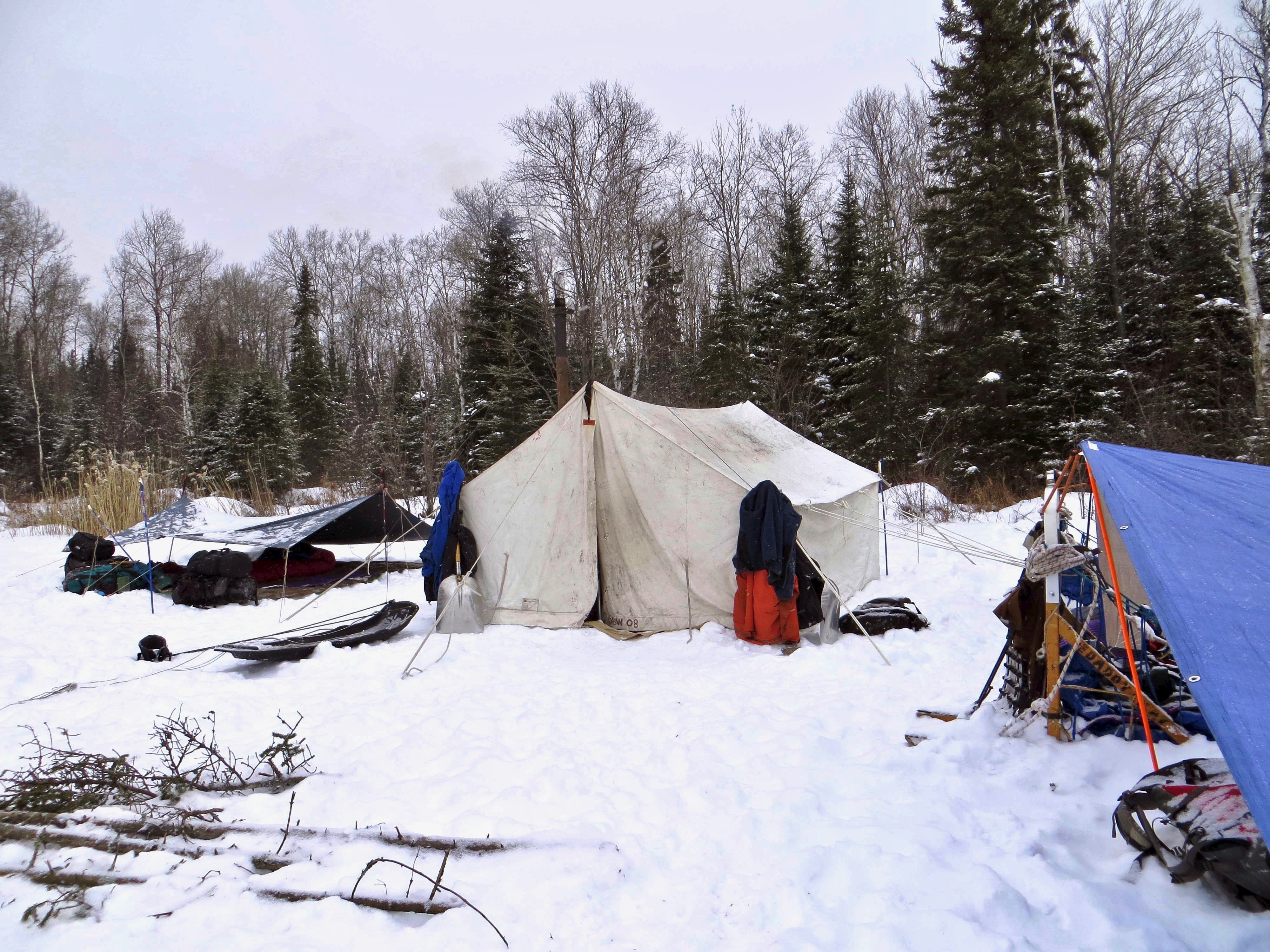
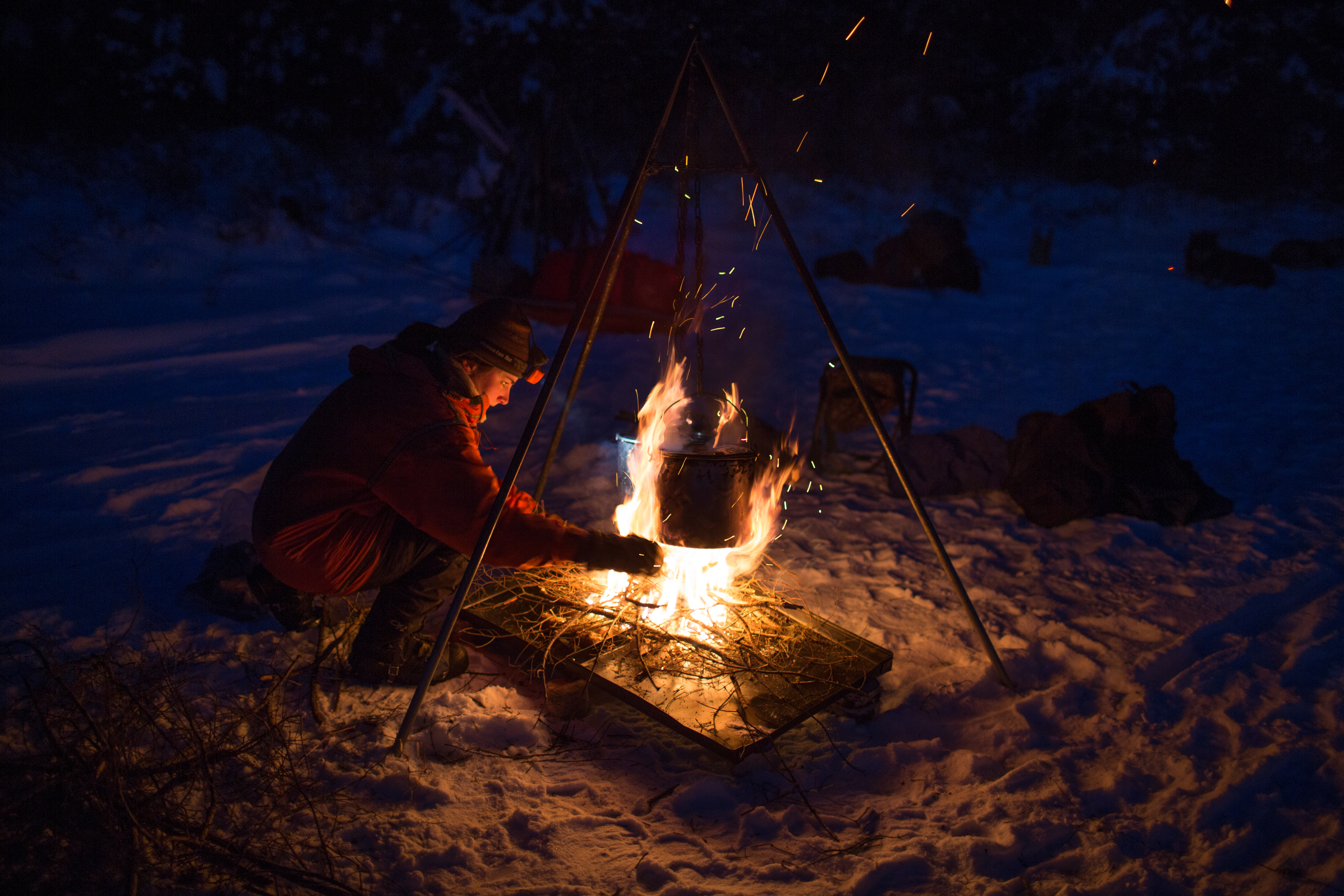
Winter camping doesn't require a tent. Instead, you'll sleep under tarps. The tarp provides protection from snowfall and wind. Underneath you will be a ground sheet and an insolite pad. You'll sleep in a double-sleeping bag system with an inner 20-degree down bag and an outer 0-degree synthetic bag.
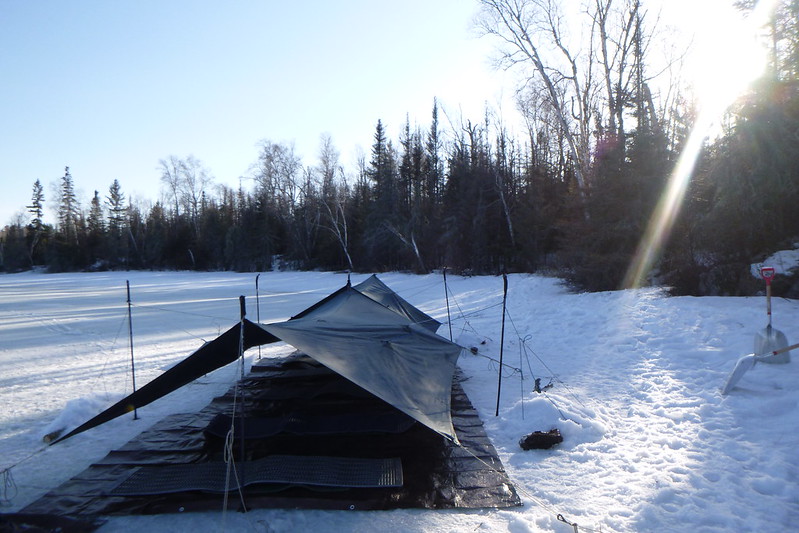
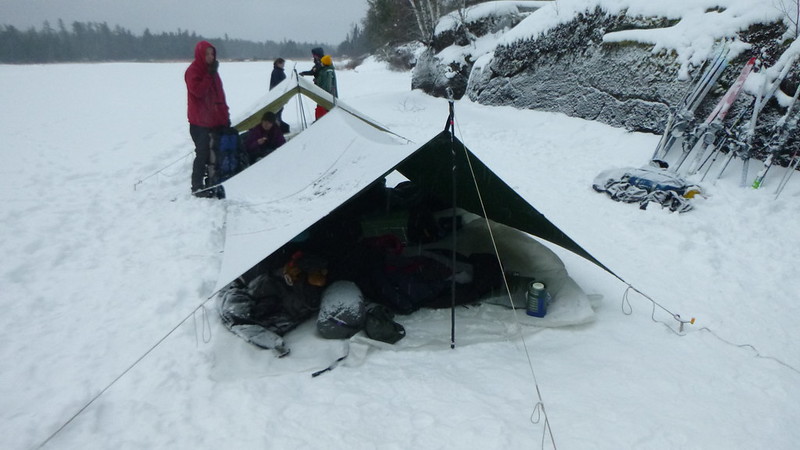
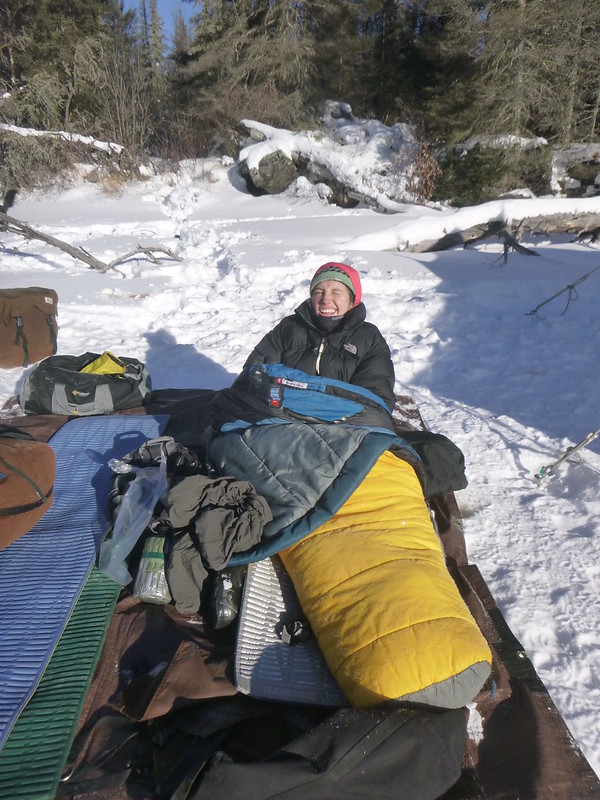
WINTER: Preparing and eating tasty meals in the backcountry is part of the Outward Bound experience.
Under your instructors' supervision, you and your crew will prepare group meals in a camp setting over an open fire. Meals are eaten as a group and may start off with group announcements, appreciations, or an inspirational quote. We use this time together to reflect on the successes and challenges of the day and to plan what is to come for the following day.
Your group will travel with all the food you need for your expedition. For some longer courses, our support staff meet up with your group in the wilderness to restock your food. This meet up is called a “re-supply.”
Our courses are physically rigorous, and our meals emphasize protein and carbohydrates to re-fuel your body. All course food is packable and non-perishable. We use a mix of dehydrated foods, fresh fruits, and vegetables. Our goal is to provide meals that are familiar. However, we ask that you be open to trying foods that may be new to you.
Participants should not bring their own food or snacks unless authorized to do so by your Course Advisor.
Our Food Pack Out Process
All meals at Outward Bound are cooked outdoors in remote camp settings. We work diligently to provide familiar and tasty foods, and we acknowledge that our food options are limited while we are on expedition, away from our supply facilities.
We depend on clear and accurate food allergy and dietary restrictions disclosed during the admission process to adequately plan and pack your group’s meals and snacks before your course start. Our processes are not designed to accommodate last minute dietary requests or to loosen dietary restrictions originally disclosed.
Dietary Restriction Options
- We can accommodate vegetarian, vegan, gluten-free, soy-free, nut-free, and various other dietary restrictions
- Soy Milk (Oat milk for those with soy allergies)
- Sunflower butter and nut-free trail mix for those with nut allergies
- Beans and hummus for vegetarians and dairy-free/vegan options
- Gluten-free noodles and oats (all our granola is gluten-free)
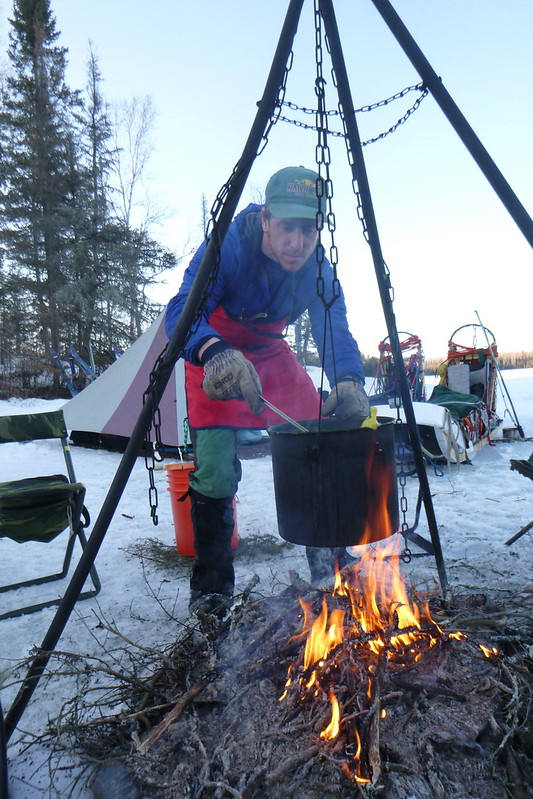
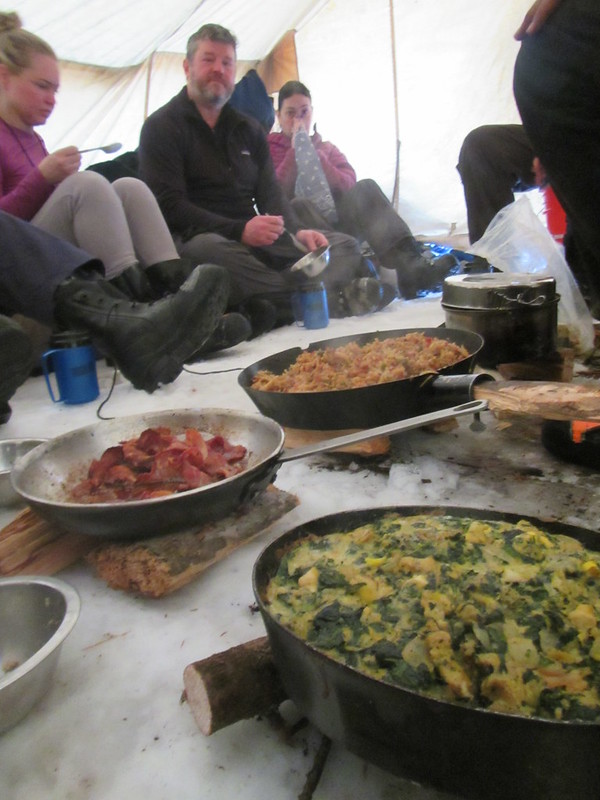
MEALS AT OUTWARD BOUND
The following list represents common meals on winter courses at Voyageur Outward Bound (this is not a menu)
Breakfasts
First Breakfast
- English muffin or bagel with sausage or bacon (veggie sausages, bean burgers, and TVP (soy-protein) patties for vegetarian/vegans)
Second Breakfast
- Breakfast bar of granola, grapenuts, oatmeal, etc. with warm water
- Granola (locally made in Ely, MN) with milk (powder)
- Oatmeal with fixins’ (raisins, pumpkin seeds, cinnamon, sugar)
- Cheesy Grits
- Grape Nuts cereal with Milk (optional: add honey or vanilla pudding powder)
- Eggs and Hashbrowns
“Squirrel Bags” (food for the day, kept with you so you can eat as you go through the day)
- Meat, cheese, dried fruit, nuts
- Meal replacement bars (house-made, three kinds: flappers (oat-based bar with raisins), “nina bars” (granola base with chocolate and peanuts), and peanut bars (peanut butter base with chocolate chips)
Cracker O’Clock - snack boost when you get to camp
Dinners
- Wild Rice Soup
- Spaghetti with Meat Sauce (ground hamburger)
- Pasta Carbonara - Alfredo Sauce with fresh eggs, peas, bacon
- Curry with Chicken or Tofu
Drinks
- Tea (both bags and house-made chai mix)
- Cocoa
- Coffee
- Drink Mixes (Lemon-Lime and Orange)
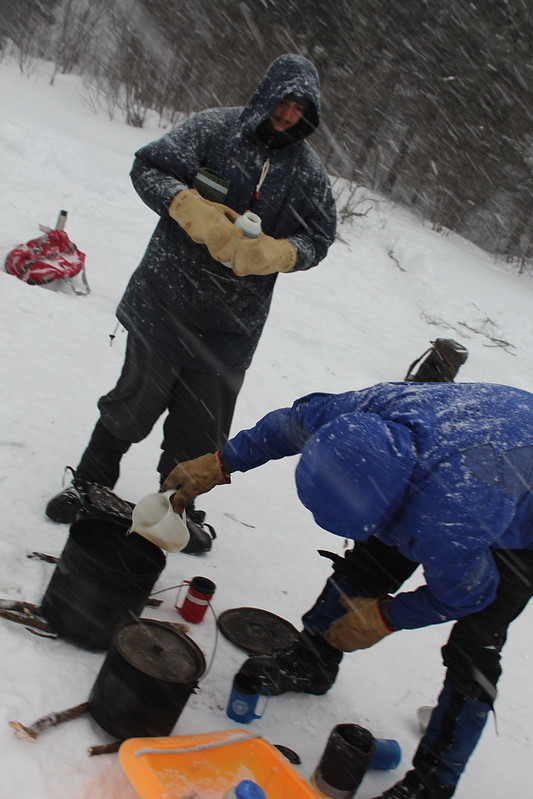
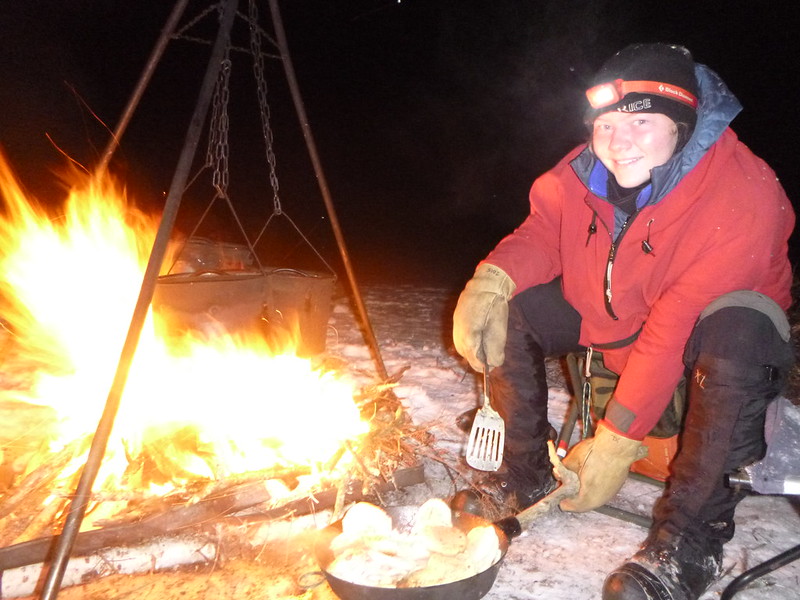
Here are some books that we encourage you to read as you plan for your course:
- The Outward Bound Wilderness First-Aid Handbook by Jeff Isaac
- Leave No Trace: A Practical Guide to the New Wilderness Ethic by Annette McGivney
- Knots & Ropes for Climbers by Duane Raleigh and Mike Clelland
- The Outward Bound Backpacker's Handbook by Glenn Randall
- The Outward Bound Map & Compass Handbook by Glenn Randall
Boundary Waters Canoe Area Wilderness:
- A Boundary Waters History: Canoeing Across Time by Stephen Wilbers
- Magic on the Rocks: Canoe Country Pictographs by Michael Furtman
- Canoe Country Flora: Plants and Trees of the North Woods and Boundary Waters by Mark Stensaas
- Reflections from the North Country by Sigurd Olson
- Talking Sky: Ojibwe Constellations as a Reflection of Life on the Land by Carl Gawboy
- Talking Rocks: Geology and 10.000 Years of Native American Tradition in the Lake Superior Region by Carl Gawboy
- Root Beer Lady: The Story of Dorothy Molter by Bob Cary
Winter Dogsledding courses:
- Cold Nights, Fast Trails: Reflections of a Modern Dog Musher by Dave Olesen
- Winterdance: The Fine Madness of Running the Iditarod by Gary Paulsen
Website Resources:
Piragis Northwoods Company: BWCAW Resouces and books
Maintaining personal hygiene in the wilderness is important and is taught on every course. You will be outside while on course and won't have access to a shower or bath. You will be able to do basic cleanup every day: brush your teeth, wash your face and comb your hair. At the end of your course, you will be able to do a more thorough cleanup.
As the Voyageur Outward Bound School is an outdoor program, you can expect to learn and use Leave No Trace camping techniques. Know that it is natural to have questions regarding sanitation in an outdoor setting. Your instructors will answer your questions and will teach you the hygienic and environmentally safe way to dispose of waste as well as techniques for basic cleanliness - don't hesitate to approach them with any questions or concerns.
